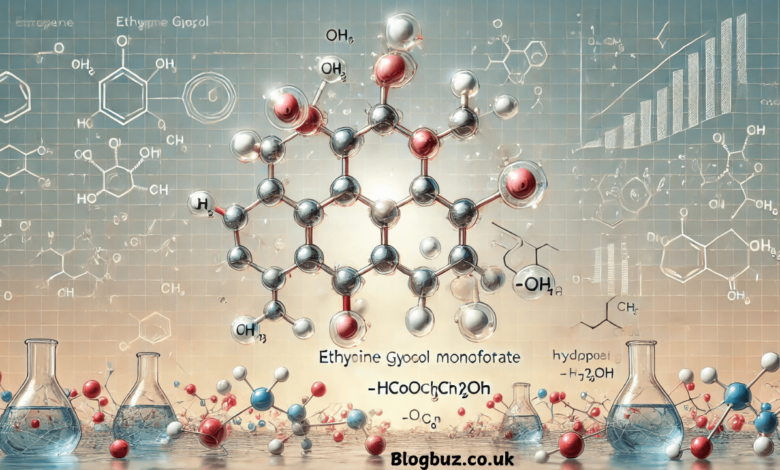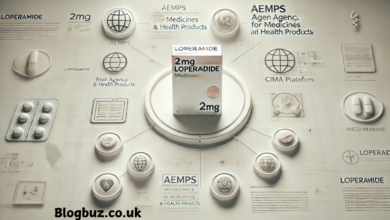HCOOCH CH2 H2O: Properties, Uses, and Applications of Ethylene Glycol Monoformate

HCOOCH CH2 H2O, also known as ethylene glycol monoformate or 2-hydroxyethyl formate, is a significant organic compound in chemical synthesis. It combines an ester (-COO-) and hydroxyl (-OH) functional groups, giving it unique properties that make it useful in various industrial applications. This article will explore the chemical properties, physical characteristics, synthesis, industrial applications, safety considerations, and environmental impact of HCOOCH CH2 H2O. Whether you’re a chemist, researcher, or student, this exhaustive guide will provide valuable insights into this versatile compound.
What is HCOOCH CH2 H2O?
HCOOCH CH2 H2O, or ethylene glycol monoformate, is an organic ester formed by the reaction of formic acid (HCOOH) with ethylene glycol (HOCH₂CH₂OH). It has polar and nonpolar characteristics due to hydroxyl and ester groups, making it a proper solvent, chemical intermediate, and reagent in various organic reactions.
Chemical Structure and Formula
- Molecular Formula: C₃H₆O₃
- Molecular Weight: ~90.08 g/mol
- IUPAC Name: 2-Hydroxyethyl formate
- Functional Groups: Ester (-COO-) and Hydroxyl (-OH)
Structural Representation
The molecular structure of HCOOCH CH2 H2O consists of a formate (HCOO—) ester-linked to an ethylene glycol (-CH₂CH₂OH) unit, forming a simple yet chemically reactive organic compound.
Physical and Chemical Properties of HCOOCH CH2 H2O
Physical Properties
| Property | Value |
|---|---|
| State | Liquid |
| Appearance | Colorless to pale yellow |
| Odor | Mild ester-like smell |
| Density | ~1.1 g/cm³ |
| Boiling Point | ~150°C |
| Solubility | Miscible with water and polar organic solvents |
Chemical Properties
- Polarity – The presence of the hydroxyl (-OH) group makes it a polar compound, allowing good solubility in water.
- Hydrolysis Reaction – It can hydrolyze in the presence of acids or bases, breaking down into ethylene glycol and formic acid.
- Reactivity – Reacts with alcohols, amines, and acids, making it a valuable intermediate in organic synthesis.
- Hydrogen Bonding – The hydroxyl group allows hydrogen bonding, increasing its solubility in polar solvents.
How is HCOOCH CH2 H2O Synthesized?
Ethylene glycol monoformate can be synthesized through esterification or transesterification reactions, where ethylene glycol reacts with formic acid or a formate ester.
Direct Esterification
The most common method involves reacting ethylene glycol (HOCH₂CH₂OH) with formic acid (HCOOH) under acidic conditions:
HOCH2CH2OH+HCOOH→HCOOCH2CH2OH+H2O
This reaction is mediated by an acid (such as sulfuric acid) and typically occurs at elevated temperatures.
Transesterification
Another method involves reacting methyl formate (HCOOCH₃) with ethylene glycol in the presence of a catalyst:
HCOOCH3+HOCH2CH2OH→HCOOCH2CH2OH+CH3OH
This method allows selective production with fewer side reactions.
Applications of HCOOCH CH2 H2O
Solvent for Organic Synthesis
Ethylene glycol monoformate is widely used as a solvent in organic reactions because of its high polarity and ability to dissolve polar compounds.
Intermediate in Ester and Polymer Production
Due to its ester group, it serves as an intermediate in producing polymers, plasticizers, and other esters used in industrial applications.
Chemical Reagent in Pharmaceuticals
In pharmaceutical chemistry, it is used as a protecting group for hydroxyl functionalities and as a reagent in drug synthesis.
Hydrolytic Agent
Because it can hydrolyze into ethylene glycol and formic acid, it is used in hydrolysis reactions, particularly in controlled acidification processes.
Cosmetic and Fragrance Industry
Its mild ester-like odor makes it useful in perfume formulations and cosmetic emulsifiers.
Safety Considerations
Toxicity and Health Effects
- Inhalation Risks – May irritate the respiratory system.
- Skin Contact – This can lead to mild skin irritation.
- Ingestion – Potentially harmful if swallowed in large amounts, leading to metabolic acidosis due to formic acid breakdown.
Storage and Handling
- Store in a cold, dry place away from heat sources.
- Use gloves, protective eyewear, and ventilated areas when handling.
- Avoid direct skin contact and inhalation of vapors.
First Aid Measures
| Exposure Type | First Aid Measure |
|---|---|
| Inhalation | Move to fresh air, seek medical attention if breathing difficulties occur. |
| Skin Contact | Wash with soap and water, remove contaminated clothing. |
| Eye Contact | Rinse with plenty of water for several minutes. |
| Ingestion | Do not induce vomiting; seek medical help immediately. |
Environmental Impact of HCOOCH CH2 H2O
- Biodegradability – HCOOCH CH2 H2O breaks down into formic acid and ethylene glycol, which are biodegradable.
- Water Pollution – High concentrations in water sources may cause acidification, affecting aquatic life.
- Eco-Friendly Alternatives – It is considered less toxic than other solvents but should still be used cautiously.
Conclusion
HCOOCH CH2 H2O, or ethylene glycol mono-formate, is an important chemical compound with applications in organic synthesis, polymer chemistry, pharmaceuticals, and cosmetics. Its unique solubility, reactivity, and hydrolytic properties make it valuable in industrial and research settings.
FAQS on HCOOCH CH2 H2O
What is ethylene glycol monoformate, and how is it formed?
Ethylene glycol monoformate (HCOOCH2CH2OH) is an organic ester formed by the reaction of ethylene glycol with formic acid. It contains an ester group (-COO-) and a hydroxyl group (-OH), making it polar and reactive.
What are the key applications of ethylene glycol monoformate in industries?
Ethylene glycol monoformate is used as a solvent in organic synthesis, a chemical intermediate in ester and polymer production, and a reagent in pharmaceutical chemistry. Due to its mild odor, it also finds applications in the cosmetic and fragrance industries.
What makes ethylene glycol monoformate an effective solvent?
Due to the hydroxyl group, the compound’s polarity allows it to dissolve polar compounds efficiently. Its ability to form hydrogen bonds further enhances its solubility in polar solvents, making it useful in various organic reactions.
How is ethylene glycol monoformate synthesized?
It can be synthesized through two main methods: direct esterification, where ethylene glycol reacts with formic acid under acidic conditions, or transesterification, where methyl formate reacts with ethylene glycol in the presence of a catalyst.
What are the environmental and safety considerations for handling ethylene glycol monoformate?
While ethylene glycol monoformate is biodegradable, high concentrations in water sources may lead to acidification, harming aquatic life. Safety precautions include using gloves and protective eyewear and working in ventilated areas, as the compound may irritate the skin and respiratory system.
You May Also Read: The Importance of 2410381-07-4 CAS No in Chemical Research and Global Standardization



